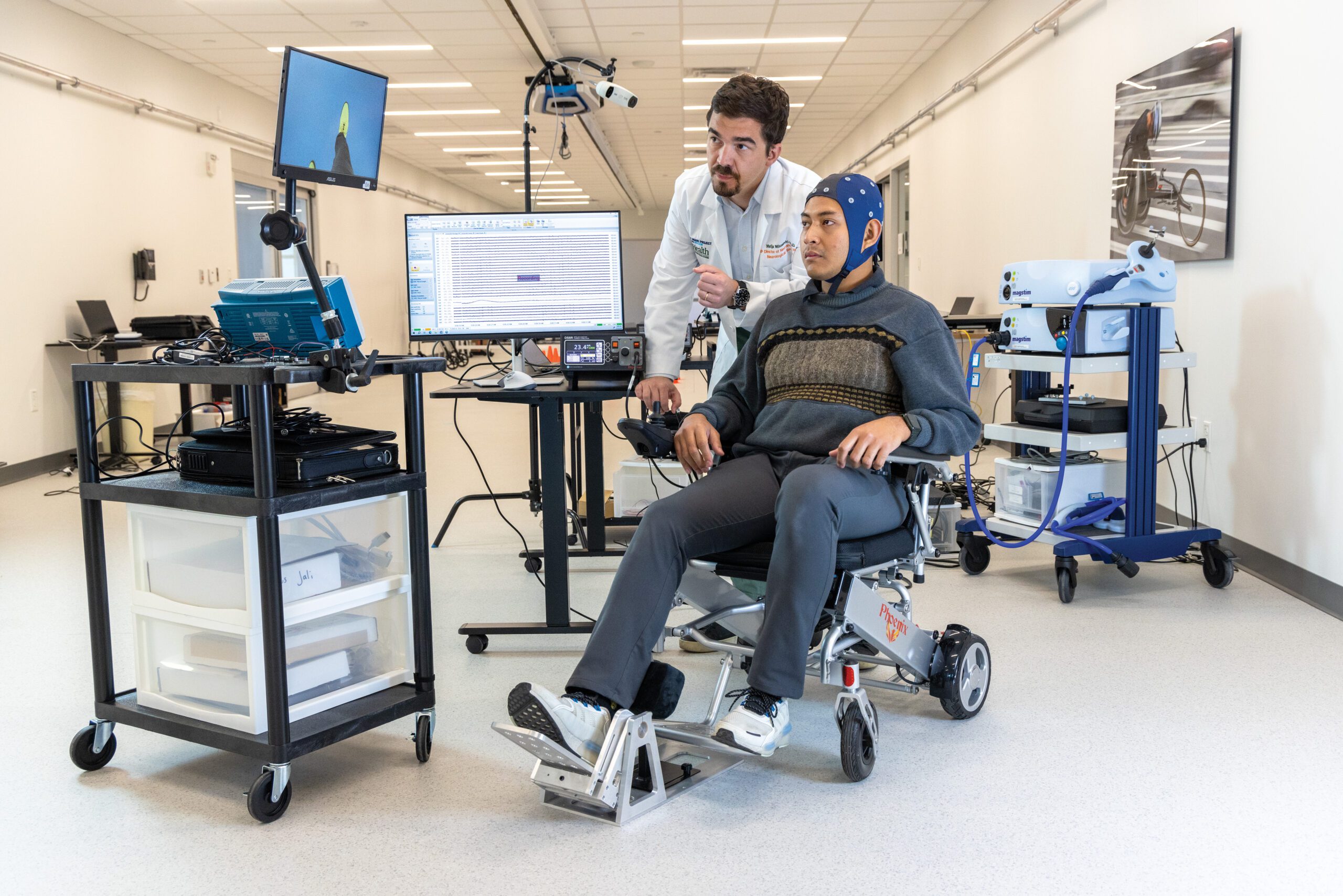(June, 2024) The Miami Project carries on a storied tradition of developing technologies that tap into the central nervous system with recent developments in detecting and interpreting electrical signals produced by the brain. Known in the industry as brain-computer interface (BCI), this technology that turns thoughts into digital commands includes recent updates from The Miami Project’s Dr. Matija Milosevic and Dr. Abhishek Prasad—each employing distinct approaches.
Dr. Matija Milosevic, recently appointed assistant professor of Neurological Surgery and Biomedical Engineering, brings to The Miami Project his laboratory of NeuroModulation, Engineering, and Therapeutics (NeuroMET Lab). Core to the laboratory is the use of brain signals from BCI to trigger stimulation that modulate neurological activity.
Now at The Miami Project, Dr. Milosevic expands from a recent focus on therapeutics that modulate the upper extremities (e.g., arm and hand) that famously human brains are wired to have more direct control over. He turns his laboratory’s focus now on lower-extremity function (e.g., standing and walking) that are more so driven by neurological activity at the level of the spinal cord. The underlying principle of intention-driven Hebbian plasticity remains the same, but different neural circuits are modulated with different functional outcomes. The importance of BCI is realized at two levels of the underlying principle. First, BCI interprets the specific intent to move in the form of electrical brain activity, allowing for closed-loop control of neuromodulatory simulators to be driven by user intent. Concurrently, BCI engages the user in an active attempt to produce movement (i.e., intent) which sends signals toward the desired-yet-interrupted target circuits in the cord. This more nuanced component is key to the Hebbian component of plasticity. Hebbian plasticity, a type of learning at the cellular level, is famously summarized as “neurons that fire together wire together.”
With motor intent from the brain as the descending signals and movement from neuromodulation as the ascending signal, the precise pairing of these two modalities is the key to tapping into Hebbian plasticity. In engineering therapeutics that take advantage of this phenomenon, Dr. Milosevic’s pioneering work seeks not to replace function but to restore it, a key distinguishing feature between his neural therapeutics and other neural prosthetics.
Concurrently Dr. Abhishek Prasad, established Miami Project scientist and associate professor of Biomedical Engineering, takes an invasive route in BCI innovation. The lab’s long line of neural interface research is now furthered by a recent NIH award of $2.79 million to investigate the impact of iron accumulation from microelectrodes placed into brain tissue. When engineering the architecture of implanted BCI detecting electrodes, the question of “on or in” the brain must be considered. For BCI sensors that sit on the surface of the brain, the presence of molecular iron from bleeding is not so much a problem. But when engineered to penetrate neurological tissue, BCI electrodes are miniaturized to cause as little damage as possible, but still face the problem of iron accumulation from the inevitable disruption of the miniscule and ubiquitous microvasculature required to supply every neuron with blood. The project will explore ways to chelate, or dissolve, the iron that accumulates around implanted BCI microelectrodes.
Despite differences in invasiveness, the BCI-enabled research programs of Drs. Milosevic and Prasad seek a similar aim—to engineer mechanisms of restoring communication and control in people living with paralysis. This neural engineering vision was recently exemplified in the doctoral dissertation project of now-Dr. Kevin Davis, an MD/Ph.D. student in the Miller School’s federally funded MSTP program. Dr. Davis’s dissertation, recently successfully defended, was conducted under the primary supervision of Dr. Prasad with collaborative research carried out in the laboratory of Dr. Milosevic. Integrating the imperative to use BCI to restore independence via a pairing with meaningful movement from neuromodulation, his dissertation included both invasive and non-invasive BCI.
In a case study, Dr. Davis shepherd the research arm of a man with tetraplegia who volunteered to have neurosurgeon Dr. Jonathan Jagid implant a BCI in the form of surface electrode over the area of his brain responsible for hand movement. At the same time a group of participants had noninvasive BCI technology detect their intended hand movement to trigger neuromodulation that stimulated grasping rehabilitation. In integrating these parallel lines of BCI research Dr. Davis’s dissertation demonstrates the potential of uniting various experts under a common mission of concurrently caring for and curing paralysis.
Interested in contributing to our BCI research? With these and other projects in the works, stay tuned and reach out to our Office of Education and Outreach with any questions, or to inquire about participation, via email at mpinfo@miami.edu or phone 305-243-7108.

